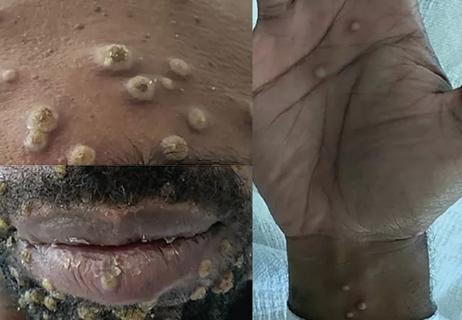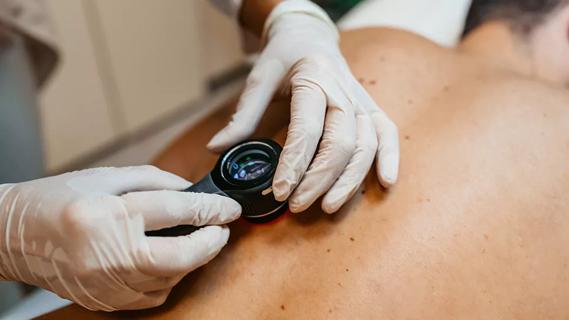Consider secondary syphilis in the differential of annular lesions

By Taylor Bullock, MD, Shruti Agrawal, MD, and Wilma Bergfeld, MD
Advertisement
Cleveland Clinic is a non-profit academic medical center. Advertising on our site helps support our mission. We do not endorse non-Cleveland Clinic products or services. Policy
A 41-year-old-male presented with a one-month history of pruritic lesions on his scalp, neck and penis. He had attempted a two-week course of terbinafine cream, with no improvement. The lesions were unaffected by exposure to sunlight. The patient also reported new-onset wrist stiffness and pain. He had been diagnosed with primary syphilis nine months before presentation, with a reactive plasma reagin titer of 1:64, and had been treated with intramuscular penicillin G benzathine 2.4 million units.
Physical examination revealed annular and petaloid plaques with central clearing and raised borders
on the scalp, right mandibular angle and penis. No lesions were observed on the oral mucosa, palms, or soles. No lymphadenopathy or new-onset alopecia was present.
Clinically, the differential diagnosis included discoid lupus erythematosus, lichen planus, tinea infection, sarcoidosis and annular secondary syphilis. Serology for human immunodeficiency virus was nonreactive, and cutaneous punch biopsy of the mandibular lesion was performed.
Histologic sections revealed numerous plasma cells within the superficial dermis to the mid-dermis. Staining for Treponema pallidum highlighted numerous spirochetes, consistent with syphilis. Repeat rapid plasma reagin testing was positive with a 1:256 titer.
Though we are not certain, we believed that this patient likely acquired a new case of syphilis after treatment of his previous infection, because he presented at nine months after the primary diagnosis, and resolution of secondary syphilis typically occurs within 12 weeks.1 Therefore, he was given an intramuscular dose of 2.4 million units of penicillin G benzathine, with close follow-up recommended with the department of infectious diseases.
Advertisement
Syphilis is a sexually transmitted disease caused by the spirochete bacterium T pallidum. While primary syphilis typically presents as a solitary, painless papule or ulcer in the genital area, secondary syphilis is a generalized infection often accompanied by systemic symptoms such as fever, malaise, headaches, sore throat or joint pain.1 These acute symptoms typically begin six to eight weeks after the appearance of the primary lesion and resolve within 12 weeks.1
The most common cutaneous presentation of secondary syphilis is a generalized morbilliform rash, usually involving the palms and soles.2 However, secondary syphilis can present as annular secondary syphilis, which is also known as petaloid syphilis, owing to its resemblance to the petals of a flower.2 Lesions in annular secondary syphilis often occur close to the angle of the mandible and frequently spare the palms and soles.3–5 Secondary syphilis typically presents without
lymphadenopathy and often affects the genitalia.5
The differential diagnosis for annular plaques is broad and depends on clinical history, symptoms and location and morphology of the lesions. Annular lesions on the head and neck could also be secondary to petaloid seborrheic dermatitis, tinea corporis, discoid lupus erythematosus, subacute lupus erythematosus, cutaneous sarcoidosis, or granuloma annulare.
A thorough history and physical examination, relevant laboratory studies, skin biopsy, and potassium
hydroxide preparation of these lesions are helpful in narrowing the diagnosis.
Advertisement
It is important for clinicians to consider petaloid secondary syphilis in the differential of annular lesions, as it can mimic other inflammatory and infectious etiologies.
This article is adapted and republished from the Cleveland Clinic Journal Of Medicine, (2023; 90[9]: 527-528).
Advertisement
Advertisement

Wound, ostomy and continence nurses provide skin assessments, wound prevention measures, treatment and education

Persistent rectal pain leads to diffuse pustules

Unique skin changes can occur after infection or vaccine

Family history may eclipse sun exposure in some cases

Two cases — both tremendously different in their level of complexity — illustrate the core principles of nasal reconstruction

Stress and immunosuppression can trigger reactivation of latent virus

Low-dose, monitored prescription therapy demonstrates success

Antioxidants, barrier-enhancing agents can improve thinning hair